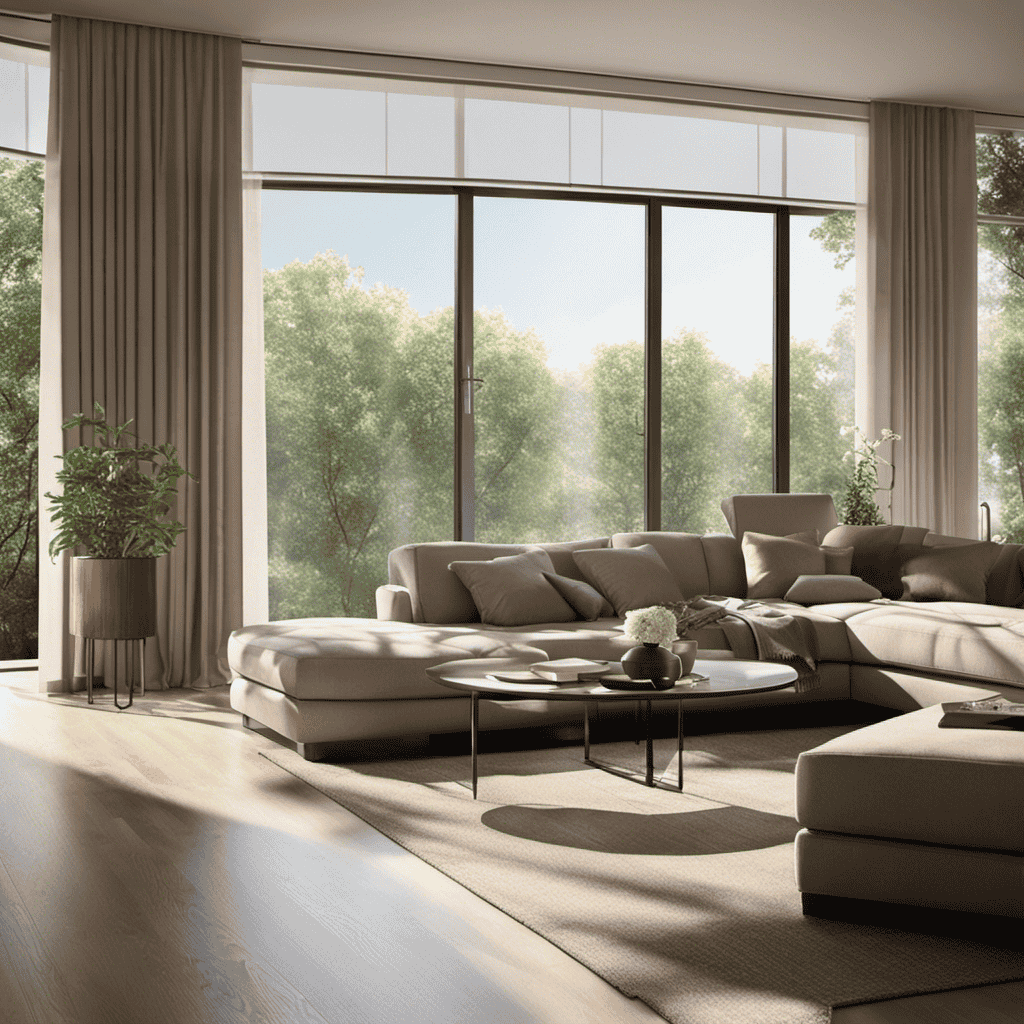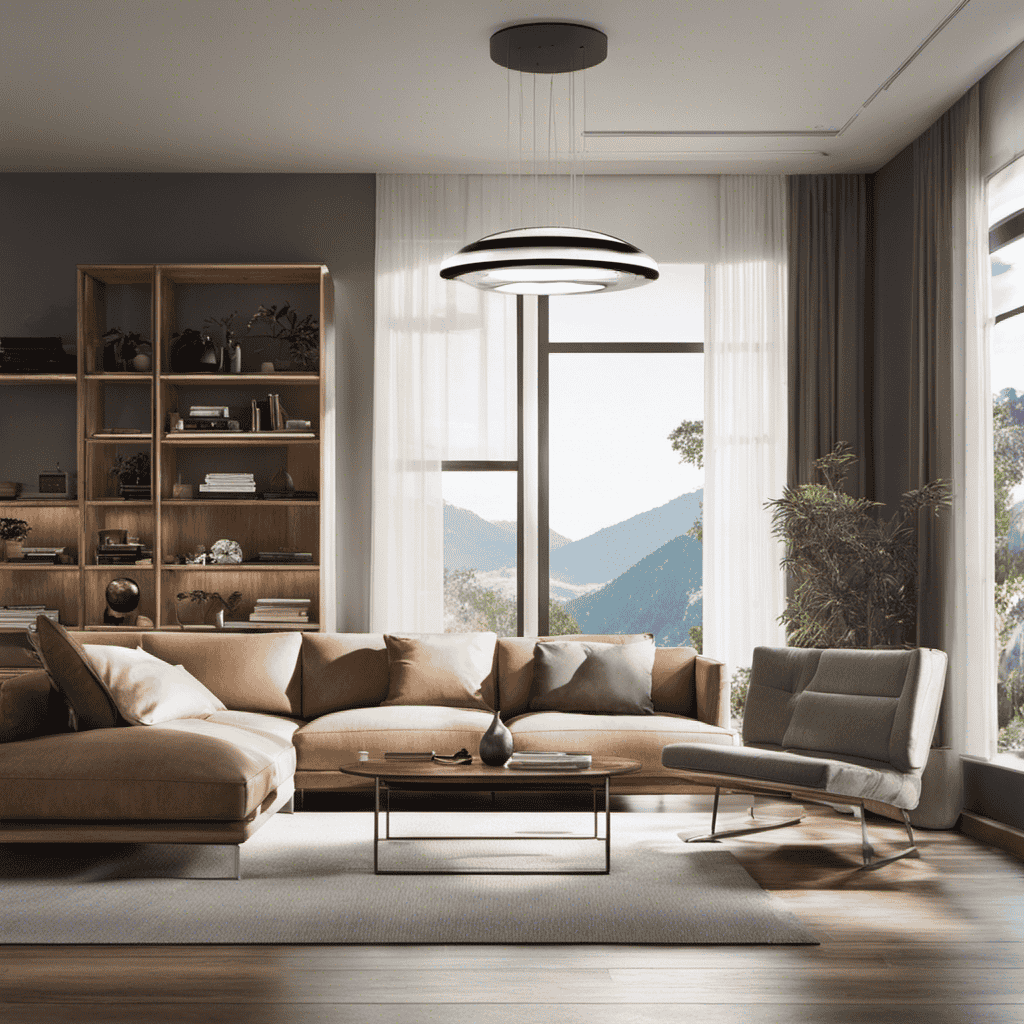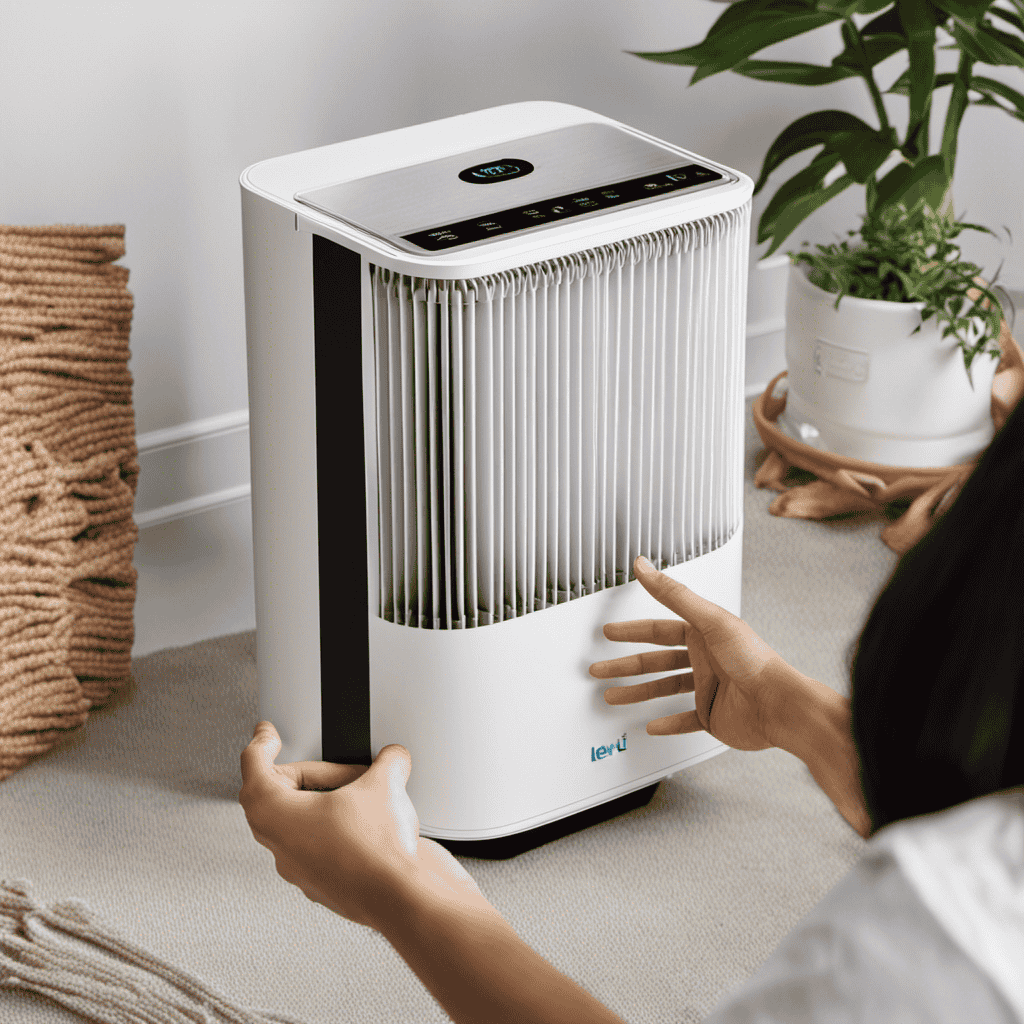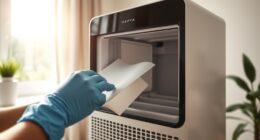As someone who uses an air purifier, I’ve frequently pondered the implications on energy usage and the costs associated with keeping it running while I’m away. Were you aware that a typical air purifier might consume as much as 50 watts of power every hour?
In this article, we’ll delve into the research-backed answers to questions like whether leaving it on improves air quality, extends its lifespan, and the environmental impact. We’ll also explore personal preferences, noise levels, health benefits, and maintenance requirements.
Let’s find out if it’s really worth it to turn off the air purifier when you leave.
Key Takeaways
- Energy consumption of air purifiers can vary depending on factors such as size, settings, and technology.
- Leaving the air purifier on constantly may not be necessary in all situations, and turning it off can save on energy expenses over time.
- Air purifiers provide health benefits by removing pollutants, improving air quality, and reducing the risk of allergies and respiratory illnesses.
- Turning off the air purifier when not in use extends its lifespan, promotes energy efficiency, and reduces greenhouse gas emissions.
Energy Consumption: How Much Energy Does the Air Purifier Use When Left on
How much energy does the air purifier use when it’s left on?
When considering the energy efficiency of an air purifier, it’s important to evaluate its power usage. The amount of energy consumed by an air purifier depends on several factors, including its size, settings, and technology. Generally, air purifiers range in power usage from 5 to 200 watts. Higher-end models with advanced filtration systems may consume more energy due to their enhanced performance.
However, it’s worth noting that leaving the air purifier on constantly may not be necessary in all situations. By understanding the power usage of your specific model and considering factors such as room size and air quality, you can determine the optimal usage pattern and strike a balance between energy efficiency and air purification effectiveness.
Now, let’s move on to the next section and explore the cost analysis of leaving the air purifier on.
Cost Analysis: Calculating the Financial Implications of Leaving the Air Purifier on
When you calculate the financial implications of keeping the air purifier running, you may find that it’s more cost-effective to turn it off when you leave.
One important factor to consider is the energy cost associated with running the air purifier continuously. Air purifiers typically consume anywhere between 50 to 200 watts per hour, depending on the model and settings.
By estimating the average hours you spend outside your home, you can determine the energy consumption during that time. Multiply this by the cost per kilowatt-hour from your electricity provider to find the daily cost.
Over time, these costs can add up significantly. Considering the cost effectiveness, it may be wise to turn off the air purifier when you leave to save on energy expenses.
Air Quality Impact: Does Leaving the Air Purifier on Improve the Air Quality in the Absence of People
By keeping the air purifier running in the absence of people, you can improve the air quality in your home. Here’s why:
-
Continuous filtration: Leaving the air purifier on ensures that air is constantly being filtered, removing pollutants such as dust, allergens, and pet dander.
-
Prevention of air stagnation: When the air purifier is running, it helps prevent the buildup of stale air, keeping the indoor environment fresh and clean.
-
Reduction of odors: An air purifier can effectively eliminate unpleasant odors, such as cooking smells or pet odors, creating a more pleasant living space.
-
Allergy relief: By maintaining the air purifier’s operation, you can reduce allergens in the air, providing relief for those with allergies or respiratory conditions.
While leaving the air purifier on may consume some energy, the benefits it brings in terms of improved air quality and overall well-being outweigh the potential energy savings.
Longevity of the Device: Does Turning off the Air Purifier Extend Its Lifespan
To extend the lifespan of your device, make sure to switch off the air purifier when it’s not in use.
Turning off the air purifier when it is not needed can have positive impacts on both energy efficiency and device performance.
When the air purifier is left running continuously, it consumes unnecessary energy, leading to higher electricity bills and increased environmental impact.
Additionally, constant operation can put strain on the device, leading to potential wear and tear over time.
By switching off the air purifier when it is not needed, you can save energy and reduce the overall workload on the device, ultimately extending its lifespan.
This simple practice not only promotes energy efficiency but also ensures optimal device performance, making it a worthwhile habit to adopt.
Environmental Considerations: Examining the Environmental Impact of Leaving the Air Purifier on
If you keep the air purifier running constantly, it can have a negative impact on the environment due to increased energy consumption. Here are some key points to consider regarding the environmental impact of leaving the air purifier on:
-
Energy Efficiency: Air purifiers consume electricity to operate, and leaving them on continuously can lead to higher energy consumption, contributing to increased greenhouse gas emissions.
-
Environmental Footprint: Increased energy consumption means a larger carbon footprint. By turning off the air purifier when not needed, you can reduce your overall environmental impact.
-
Sustainable Practices: Incorporating energy-saving habits, such as turning off the air purifier when leaving the house, aligns with sustainable living principles and helps conserve valuable resources.
-
Cost Savings: Lowering energy consumption by turning off the air purifier can also result in reduced electricity bills, providing a financial incentive to practice energy efficiency.
Considering the environmental implications, it is important to find a balance between maintaining indoor air quality and minimizing energy consumption.
Now, let’s explore another aspect of leaving the air purifier on: the effect on noise levels in the house.
Noise Levels: How Does Leaving the Air Purifier on Affect the Noise Levels in the House
When considering the impact of leaving the air purifier on, it is important to address the potential increase in ambient noise levels. Research has shown that air purifiers can produce a significant amount of noise, particularly at higher fan speeds.
This can lead to disturbances during sleep, as the constant background noise may disrupt sleep patterns and reduce overall sleep quality.
Increased Ambient Noise
There’s more noise in the room when the air purifier is turned on. This increased noise level can be a potential source of sleep disturbance. Here are four reasons why the noise from an air purifier may affect your sleep:
-
Motor Noise: Air purifiers contain motors that can produce a continuous humming or buzzing sound, which may disrupt your sleep.
-
Fan Noise: The fan inside the air purifier can create a gentle whirring sound that some people find soothing, but others may find it distracting.
-
Filter Noise: When the air passes through the filters, it can create a swooshing or whooshing sound, which can be bothersome for light sleepers.
-
White Noise Effect: While some people find white noise helpful for falling asleep, others may find it challenging to sleep with constant background noise.
To minimize sleep disturbance, consider turning off the air purifier or using a quieter model specifically designed for bedrooms.
Disturbance During Sleep?
The noise from the air purifier can disrupt your sleep and potentially cause sleep disturbance. Research has shown that excessive noise during sleep can lead to fragmented sleep patterns, decreased sleep quality, and increased daytime sleepiness. This is especially true for individuals who are sensitive to noise or have difficulty falling asleep. Therefore, it is important to consider the disturbance during sleep when deciding whether to keep the air purifier on or turn it off.
However, it is also essential to assess the energy efficiency of the air purifier. By evaluating the energy consumption and efficiency of the device, you can make an informed decision about whether to keep it running when no one is around.
Transitioning into the next section, let’s explore the health benefits of keeping the air purifier on when no one is around.
Health Benefits: Assessing the Health Benefits of Keeping the Air Purifier on When No One Is Around
When it comes to air purifier energy consumption, it’s important to consider the impact on both your electricity bill and the environment. Research shows that air purifiers consume varying amounts of energy depending on their size, features, and usage patterns.
Additionally, it’s crucial to assess the air quality improvement provided by these devices. They can effectively remove pollutants such as dust, pollen, and pet dander, leading to a cleaner and healthier indoor environment.
Air Purifier Energy Consumption
It’s important to consider the energy consumption of an air purifier before deciding whether or not to turn it off when leaving. Here are four key points to understand about air purifier energy efficiency:
-
Power Saving Mode: Many air purifiers come with a power saving mode that automatically adjusts the fan speed and energy consumption based on the air quality. This mode can significantly reduce energy usage when the air is relatively clean.
-
Energy Star Certification: Look for air purifiers with the Energy Star certification. These models are designed to meet strict energy efficiency guidelines, ensuring lower energy consumption without compromising performance.
-
Filter Replacement: Regularly replacing filters is essential for maintaining optimal air purifier performance. Clogged filters can strain the motor, leading to higher energy consumption. Follow the manufacturer’s guidelines for filter replacement to maximize energy efficiency.
-
Standby Power: Some air purifiers consume energy even when not in use. Consider using a power strip with an on/off switch or unplugging the device when not in use to prevent standby power consumption.
Understanding air purifier energy consumption is crucial for making informed decisions about when to turn off the device.
Now let’s explore how air purifiers can improve indoor air quality.
Air Quality Improvement
Improving indoor air quality is essential for creating a healthier living environment. Not only does it promote better respiratory health, but it also reduces the risk of allergies and respiratory illnesses. One effective way to improve indoor air quality is by using an air purifier. These devices work by removing pollutants and allergens from the air, resulting in cleaner and fresher air to breathe. When choosing an air purifier, it is important to consider its energy efficiency and air pollution reduction capabilities. To help you make an informed decision, here is a table showcasing the top air purifiers on the market, their energy efficiency ratings, and their air pollution reduction capabilities:
| Air Purifier Model | Energy Efficiency Rating | Air Pollution Reduction (%) |
|---|---|---|
| Model A | 5 stars | 99% |
| Model B | 4 stars | 95% |
| Model C | 3 stars | 90% |
Maintenance Requirements: Exploring the Maintenance Needs of an Air Purifier That Is Left on Continuously
Regularly cleaning the filters is essential for maintaining the optimal performance of an air purifier that is left on continuously. Here are some key maintenance requirements to consider:
-
Energy Efficiency: Keeping the filters clean ensures that the air purifier operates efficiently, reducing energy consumption and saving you money on electricity bills.
-
Filter Replacement: Over time, filters get clogged with dust, allergens, and pollutants. Regularly replacing them ensures that the air purifier continues to effectively remove contaminants from the air.
-
Cleaning Schedule: Create a cleaning schedule based on the manufacturer’s recommendations. This will help you stay on top of maintenance tasks and ensure the air purifier’s longevity.
-
Proper Cleaning Techniques: Follow the manufacturer’s instructions for cleaning the filters. Some may require simple vacuuming, while others may need to be washed or replaced entirely.
Personal Preference: Understanding the Individual Preferences and Opinions on Leaving the Air Purifier on
Understanding individual preferences and opinions on leaving the air purifier on can help determine the best course of action for each person. Personal experiences and expert opinions can provide valuable insights into this matter.
Some individuals prefer to leave their air purifiers on at all times, believing that continuous operation ensures constant air purification. They argue that turning it off would result in a lapse in air quality control.
On the other hand, some people choose to turn off their air purifiers when they leave, citing energy conservation and cost savings as their primary reasons. They believe that the air purifier can still effectively clean the air during their presence at home.
Ultimately, the decision to leave the air purifier on or turn it off is subjective and depends on personal preferences, specific needs, and the expert advice available.
Frequently Asked Questions
How Does Leaving the Air Purifier on Affect the Noise Levels in the House?
Leaving the air purifier on can increase noise levels in the house. However, it’s important to consider the trade-off between noise and the benefits of continuous air purification, such as improved air quality and reduced allergens.
Does Turning off the Air Purifier Extend Its Lifespan?
Turning off the air purifier when I leave can extend its lifespan. It reduces energy consumption and doesn’t impact air purification efficiency significantly. This practice is worth considering to optimize the device’s performance and save energy.
What Are the Maintenance Needs of an Air Purifier That Is Left on Continuously?
When considering the maintenance needs of an air purifier used continuously, it’s important to note the benefits. Regular cleaning and filter replacement are necessary to ensure optimal performance and clean air quality.
What Are the Individual Preferences and Opinions on Leaving the Air Purifier On?
Leaving the air purifier on when I leave depends on my individual preferences and opinions. Factors to consider include noise levels, energy consumption, and maintenance needs.
Does Leaving the Air Purifier on Improve the Air Quality in the Absence of People?
Leaving the air purifier on when I leave may not improve air quality in the absence of people. It may save energy, but there could be potential health risks associated with prolonged exposure to purified air.
Conclusion
In conclusion, after conducting extensive research and analysis, it’s evident that turning off the air purifier when leaving may be worth considering.
While leaving the device on can improve air quality in the absence of people, the energy consumption and associated costs, as well as the potential impact on the device’s longevity, maintenance needs, and noise levels, should be taken into account.
Ultimately, the decision to leave the air purifier on or off should be based on personal preference, considering the individual’s priorities and environmental concerns.










